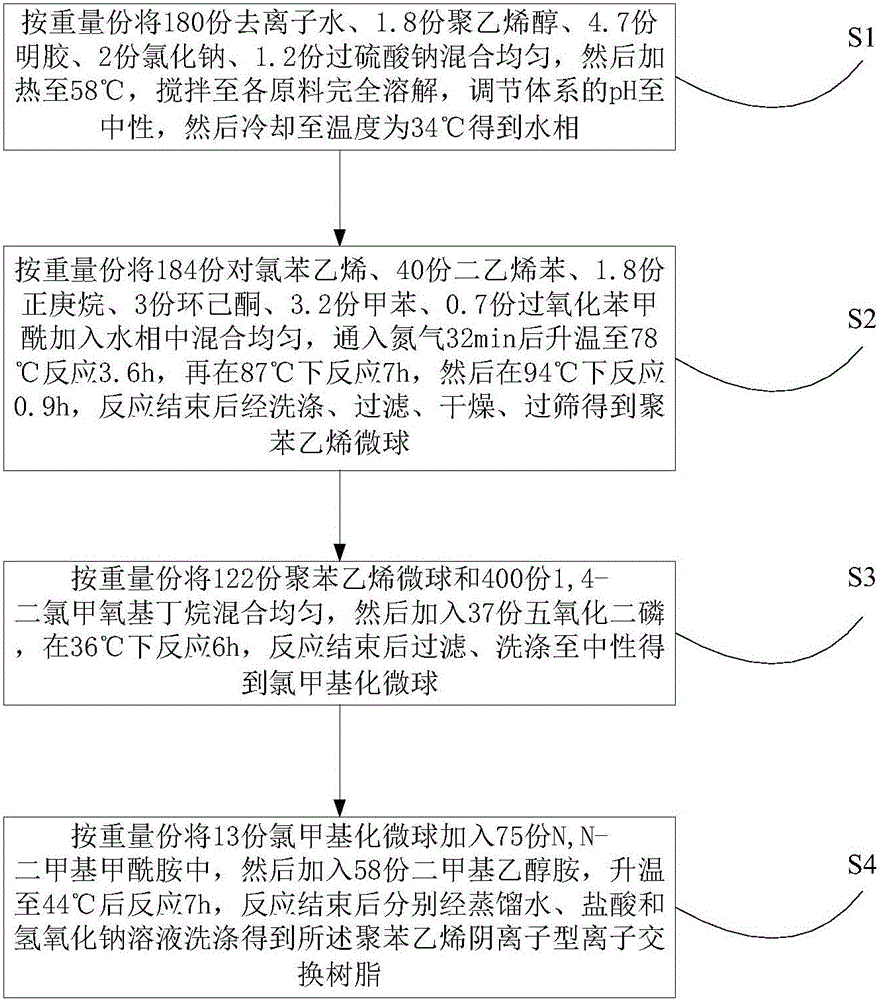Preparation method of polystyrene anion-type ion exchange resin
An ion-exchange resin and anion-type technology, applied in the direction of anion exchange, ion exchange, chemical instruments and methods, etc., can solve the problems of complex product structure and unsatisfactory resin exchange performance, and achieve high ion exchange rate, improve the degree, The effect of reducing side effects
- Summary
- Abstract
- Description
- Claims
- Application Information
AI Technical Summary
Problems solved by technology
Method used
Image
Examples
Embodiment 1
[0029] The preparation method of the polystyrene anionic ion-exchange resin that the present invention proposes may further comprise the steps:
[0030] S1. Mix 180 parts of deionized water, 2.6 parts of polyvinyl alcohol, 3.7 parts of gelatin, 2.6 parts of sodium chloride, and 1.3 parts of sodium persulfate in parts by weight, then heat to 60 ° C, stir until all raw materials are completely dissolved, and adjust The pH of the system is neutral, and then cooled to a temperature of 38° C. to obtain an aqueous phase;
[0031] S2, 175 parts of p-chlorostyrene, 42 parts of divinylbenzene, 2.6 parts of n-heptane, 4.7 parts of cyclohexanone, 3.2 parts of toluene, and 0.6 parts of benzoyl peroxide are added to the water phase and mixed uniformly by weight. Inject nitrogen for 30 minutes, raise the temperature to 76°C and react for 3.2h, wherein, during the process of raising the temperature to 76°C, the heating rate increases gradually, and the average heating rate is 1.2°C / min, then...
Embodiment 2
[0035] The preparation method of the polystyrene anionic ion-exchange resin that the present invention proposes may further comprise the steps:
[0036] S1. Mix 130 parts of deionized water, 3 parts of polyvinyl alcohol, 3 parts of gelatin, 5 parts of sodium chloride, and 0.5 parts of sodium persulfate in parts by weight, then heat to 65°C, stir until all raw materials are completely dissolved, and adjust The pH of the system is neutralized, and then cooled to a temperature of 30° C. to obtain an aqueous phase;
[0037]S2, add 200 parts of p-chlorostyrene, 30 parts of divinylbenzene, 3 parts of n-heptane, 4 parts of cyclohexanone, 4 parts of toluene, and 0.5 part of benzoyl peroxide into the water phase and mix uniformly by weight. After entering nitrogen for 35 minutes, heat up to 70°C for 5 hours, then react at 85°C for 8 hours, and then react at 92°C for 1 hour. After the reaction, wash, filter, dry, and sieve to obtain polystyrene microspheres;
[0038] S3. Mix 100 parts ...
Embodiment 3
[0041] The preparation method of the polystyrene anionic ion-exchange resin that the present invention proposes may further comprise the steps:
[0042] S1. Mix 200 parts of deionized water, 1 part of polyvinyl alcohol, 5 parts of gelatin, 1 part of sodium chloride, and 2 parts of sodium persulfate in parts by weight, then heat to 55 ° C, stir until all raw materials are completely dissolved, and adjust The pH of the system is neutralized, and then cooled to a temperature of 40° C. to obtain an aqueous phase;
[0043] S2, add 150 parts of p-chlorostyrene, 50 parts of divinylbenzene, 1 part of n-heptane, 5 parts of cyclohexanone, 3 parts of toluene, and 1 part of benzoyl peroxide into the water phase and mix evenly by weight. After entering nitrogen for 20 minutes, heat up to 80°C for 3 hours, then react at 90°C for 8 hours, and then react at 98°C for 0.3 hours. After the reaction, wash, filter, dry, and sieve to obtain polystyrene microspheres;
[0044] S3. Mix 150 parts of p...
PUM
 Login to View More
Login to View More Abstract
Description
Claims
Application Information
 Login to View More
Login to View More - R&D
- Intellectual Property
- Life Sciences
- Materials
- Tech Scout
- Unparalleled Data Quality
- Higher Quality Content
- 60% Fewer Hallucinations
Browse by: Latest US Patents, China's latest patents, Technical Efficacy Thesaurus, Application Domain, Technology Topic, Popular Technical Reports.
© 2025 PatSnap. All rights reserved.Legal|Privacy policy|Modern Slavery Act Transparency Statement|Sitemap|About US| Contact US: help@patsnap.com

